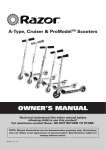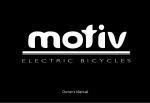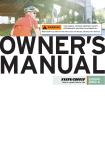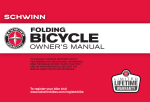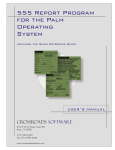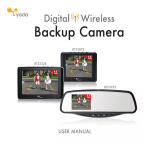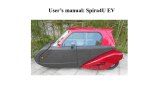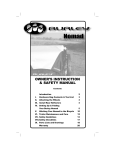Download Schwinn Fastback Trailer Owner's Manual
Transcript
OWNER’S MANUAL FASTBACK™ TRAILER All of us at Schwinn strongly encourage you to read this manual before you go riding with your trailer for the first time. Your time reading this manual and learning about your Schwinn trailer will return many hours of safe biking pleasure. IMPORTANT! If a minor will be riding a bicycle with this trailer attached, it is essential that a responsible adult/parent read the Owner’s manual to the minor. So what are you waiting for? Sit down for a bit and read this manual to familiarize yourself with your new trailer, and start riding. Like any sport, bicycling involves a risk of injury and damage. By choosing to ride a bicycle, with or without a trailer, you assume the responsibility for that risk. Not the people who sold you the trailer. Not the people that made it. Not the people who distribute it. You! If you have any questions or problems that can’t be answered by your Authorized Schwinn Dealer, we welcome your letter. SCHWINN CYCLING & FITNESS INC. Consumer Relations Department 1690 38th Street Boulder, CO 80301 2 WARNING! GENERAL WARNING: Bicycling can be a hazardous activity even under the best of circumstances. Proper maintenance of your bicycle and trailer is your responsibility as it helps reduce the risk of injury. This manual contains many “Warnings” and “Cautions” concerning the consequences of failure to maintain or inspect your trailer. Be sure to read and understand all of the Warnings and Cautions. Many of them refer to circumstances in which you may lose your balance and fall, which in turn may lead to serious personal injury or death to you and/or your passenger. TRAILER USE: Use of a trailer changes the handling characteristics and requirements of your bicycle, and also entails its own special risks. Be sure to carefully read and understand the section in this Manual on “Trailer Use”. Failure to be aware of and responsive to the special characteristics of riding with a trailer may lead to serious personal injury or death, to you and/or your passenger. 3 TRAILER USE • Extra care in riding must be exercised when pulling your trailer. Your bicycle will ride much differently when pulling a trailer. The extra weight of the trailer, passenger and cargo will make your bike less responsive. You will need to ride slower than you would on a bicycle without a trailer. The trailer is much longer than a bicycle without a trailer. Use extra care in all situations. • It will be harder and slower to get started and up to speed because of the extra weight. • It will take longer to cross streets and paths because of the extra length. • The bicycle with a trailer will require extra stopping distance because of the extra weight. • While riding your bike with a trailer down hills you will gain speed more quickly than on a bike alone. While riding down hills you will need to use your brakes early and often to keep your speed under control. Remember to apply the rear brake before the front brake. • Turning around corners should be gradual and slow. Your trailer will handle differently in turns than your bicycle. • It is not recommended to ride the trailer over curbs, pot holes or other road hazards. We recommend you ride your bike with the trailer in an open area without traffic to get comfortable with how your bicycle will ride with a trailer. • This trailer was designed to be used on smooth roads. The trailer could be damaged and your passenger injured if the trailer is used on off-the-road trails or otherwise off-road. • Help people see that you are pulling a trailer: always use the flag supplied with the trailer, and avoid riding at night. WARNING! 4 Failure to be aware of and respond to the special characteristics of riding your bicycle with a trailer may lead to serious personal injury or death to you and/or your passenger. Be sure to practice riding your bike with the trailer in an open area without traffic until you are comfortable and familiar with the way it handles. WET RIDING CONDITIONS CAUTION! Riding a bicycle, with or without a trailer attached, with wet rims and/or tires requires extra braking distances and slower riding speeds. Braking a bicycle, with or without a trailer attached, with wet rims is a potentially dangerous situation. You will require a lot of extra distance to stop safely, especially with a trailer attached. There is no doubt that you will be caught in a rainstorm while riding. You will be surprised at how water cuts braking ability! The rule of thumb here is simply ride more slowly, allow more time and distance for stopping and apply both front and rear brakes intermittently to avoid skidding. NIGHT RIDING Night riding with a trailer is strongly discouraged because it is much harder to be seen as a cyclist. Your own vision is also reduced at dusk and at night. LIGHTS The best way to increase your ability to see and be seen if you must ride at night is to use a high-quality front headlight and a bright blinking rear red light. Do not ride in the dark without front and rear lights. Put a rear light on the trailer as well. REFLECTORS Federal regulations require every bicycle (except children’s “sidewalk” bikes) to be equipped with front, rear, wheel and pedal reflectors. The size, performance and location of each reflector is specified by the US Consumer Product Safety Commission. Your Schwinn trailer has reflectors. The purpose of these reflectors is not just to protect you as a bike rider from being accidentally hit by a car or other road user if you’re out riding after dusk, but also to keep you from scaring other road users by suddenly appearing out of the dark. The reflectors are designed to pick up and reflect street lights and car lights in a way that clearly identifies you as a moving bicyclist. Removing the reflectors may reduce your visibility to others using the roadway. Always remember, however, that the reflectors are not substitutes for front and rear lights. 5 CAUTION! If you must ride at night: Be sure you see a front headlight and a blinking red rear light on both the bike and the trailer. Be sure your front, rear, and pedal bicycle reflectors are clean and in their proper positions and that the reflectors on your trailer are clean. Have your dealer replace damaged reflectors and tighten any that may have loosened. Reflectors are not substitutes for lights—use a front headlight and a blinking red rear light on both the bike and the trailer. Wear reflective clothing and be sure accessories such as racks, bags, etc. have reflectors. State or local laws may require that you equip your bike with a light system in addition to the reflectors. Contact your local authorities for the bicycling laws in your area. Wear a CPSC approved helmet. NEVER LET CHILDREN RIDE AT NIGHT. The Schwinn Fastback Trailer will fold down for easy storage. IMPORTANT! All references to orientation are as viewed from the rear of the trailer. FOLDING THE TRAILER Folding the trailer is a simple four step process: 1. Remove the rider and remove the trailer from the towing bike. Fig. 1 2. Remove the flag from the flag holder. Pull up on the flag pole to remove. 3. Lift up on the quick release lever and unscrew the lever from the frame. Fig. 1 4. Fold the tow arm down.Fig. 2 Fig. 2 6 UNFOLDING THE TRAILER 1. Un-fold the arm and screw the quick release pin into the threaded hole. 2. Continue to tighten the lever until sufficient tension is achieved to allow the lever to allow the lever to flip easily 90 degrees. Then force the lever to the frame locking it in place. 3. Insert the flag into the flag pocket. 1. Attaching the Trailer To The Bike This hitch is designed to adjust to a wide range of seat post sizes. The hitch has a quick release cam lever that locks the hitch clamp to the seat post. The seat post size needs to be initially set with a 5mm allen wrench for each unique size seat post. Initial Hitch Set-Up 1. Inspect the seat post on the lead bike for dents, cracks, scrapes and deep scratches replace the seat post if any of these conditions exist. Also note the seat post must have a wall thickness of at least 1/8". Remove the seat post to check the wall thickness. See Fig. 3 Fig. 3 2. Open the seat post clamp by flipping the quick release lever away from the center of the hitch you may need to loosen the quick release adjusting nut several turns to remove the lever assembly from the slot. 3. Position the hitch around the seat post. See Fig. 4 4. Re-attach the quick release lever in the slot and tighten the nut about 1/2 the way down the Fig. 4 threaded lever assembly bolt and close the quick release lever by flipping the lever 180 degrees towards the center. 5. Using a 5mm allen wrench, evenly adjust the 2 range limit screws so the hitch is tight to the seat post. Note: The hitch should not rotate around the seat post. See Fig. 5 Fig. 5 7 Attaching the Hitch After The Initial Set-Up 1. Inspect the seat post on the lead bike for dents, cracks, scrapes and deep scratches replace the seat post if any of these conditions exist. 2. Open the seat post clamp by flipping the quick release lever away from the center of the hitch you may need to loosen the quick release adjusting nut several turns to remove the lever assembly from the slot. 3. Position the hitch around the seat post. See Fig. 4 4. Re-attach the quick release lever in the slot and tighten the nut about half the way down the threaded lever assembly bolt and close the quick release lever by flipping the lever 180 degrees towards the center. If the lever will not completely close then loosen the nut and try again. If the lever closes but the hitch rotates around the seat post then tighten the nut and try again. See Fig. 6 WARNING! WARNING! 8 Fig. 6 WARNING! Attaching this trailer to a lead bike with a seat post with dents, cracks, scrapes and deep scratches or to a seat post with a wall thickness less than 1/8", can result in the seat post breaking, causing the trailer to separate from the bike and may cause loss of control of the trailer and bike and may result in severe personal injury or death to the rider and /or passenger. WARNING! Using the trailer with a bent, dented or scratched tow arm may result in the tow arm breaking, causing the trailer to separate from the bike and may cause loss of control of the trailer and bike and may result in serious personal injury or death to the rider and/or passenger. IMPORTANT ALWAYS PERFORM A PRE-RIDE CHECK FRAME FOLD JOINT QUICK RELEASE LEVER Make sure the quick release levers are in the fully locked position. FLAG Make sure the flag is assembled and installed in the flag holder. HELMETS Make sure rider and passenger are wearing proper helmets properly secured. HITCH CLAMP Make sure the hitch is securely fastened. TIRE PRESSURE Make sure the tires are not overinflated, 35 PSI maximum. WHEN OTHERS USE YOUR TRAILER If you allow someone to use your trailer, perform the preceding PreRide Check yourself before allowing that person to ride with the trailer attached. Be sure that the person understands the differences between riding with the trailer attached. Be sure that the person understands the differences between riding with and without the trailer and has practiced using the trailer without a passenger. 9 GENERAL Safe biking is an important concern of all bike manufacturers. Here at Schwinn, we are constantly striving to educate our customers about safe biking habits. Using common sense is usually the best way to ride safely and get the most out of biking. Here are some common sense ideas to keep in mind whenever you ride your bike, with or without a trailer: • Familiarize Yourself With Your State Laws Many states require different safety devices. It is your responsibility to familiarize yourself with the laws of the state where you ride, and to comply with all applicable laws, including properly equipping your bicycle. • Be Sure You Thoroughly Understand How to Operate the Components on Your Bike and Trailer Practice riding in a quiet area to get the feel for how your bike rides differently with a trailer. • Always Do A Mechanical Safety Check Before Riding Be sure all the equipment is adjusted properly, especially the brakes. Make sure all quick release devices on the bicycle are in the closed position. • Always ride Defensively While you may be legally in the right, in a contest between an auto and a bike, the auto will come out first. Always be on the lookout for potentially dangerous situations. • Always Ride Single File Riding two or three abreast can only lead to trouble. • Never Bike With Personal Radios or Headphones On They can cover up the sound of traffic or emergency vehicles. Hearing what is going on around you is important for safe biking. Many states have even made it illegal to wear these types of devices while biking. Check your local laws. 10 HELMETS, APPAREL & BEING SEEN WEAR A HELMET! Always wear a helmet when riding your bicycle, and make sure the trailer passenger also wears a helmet, no matter how short the ride. Always keep the chin strap on each helmet securely buckled. A good helmet offers excellent impact resistance and protection against head injury. Schwinn sells a helmet that meets CPSC safety requirements. It must fit properly and be worn correctly to do the job properly. WARNING! Always wear a helmet when riding a bike and make sure each trailer passenger also wears a helmet. Always keep the chinstrap securely fastened. Failure to wear a helmet which meets the CPSC safety requirements may result in serious personal injury or death. APPAREL Tired feet make for a tired cyclist. Wear shoes that grip the pedals and the ground well. Never ride barefoot or with the kind of sandals that your feet can accidentally slide out of. Schwinn padded cycling gloves are helpful for hand protection and comfort when riding for any amount of time. Wear bright, visible clothing. Always use the flag that comes with the trailer. If you absolutely must ride on streets at night, it is critical that you be even more cautious and that you use proper lights. Any kind of riding involves airborne dirt, dust and bugs, so it’s a good idea to ride with protective eyewear — tinted when the sun is bright, clear when it’s not. Most bike shops carry protective fashion eyewear, some with interchangeable lens systems. 11 SPECIAL PRECAUTIONS FOR RIDING ON THE STREET Sharing the road with cars is a fact of life for cyclists. You can make your biking experiences more fun by applying a simple rule: make life easier for drivers. It’s true because it’s in our best interest to make the road a safer, more pleasant place. Put yourself in a position where you minimize the chance for conflict with both drivers and their cars. It’s your responsibility to know and obey all rules of the road. Here are a few common sense ideas that will make riding on streets more fun and safe: 1. Keep right - this most basic rule of sharing the road is the one that cyclists are most casual about. Avoiding hazards, stay as far to the right as possible. Never ride against traffic. Always be aware of the extra length of your trailer. 2. Know your local bicycle riding laws - the traffic rules that motorized vehicles follow also apply to you. In addition, many states and localities have certain rules that apply to bicycles specifically, such as riding on the right-hand side of the road in single file. Contact your local authorities for the bicycling laws for your area. 3. If you absolutely must ride at night, wear light colored clothes, and always use a headlight and a blinking red rear light on your bike and trailer. 4. Watch for pedestrians. 5. Riding surfaces can be hazardous - be aware that even smooth roads can be dangerous, since there may be a pothole or surface condition that could cause you to loose control. 6. Never ride your bike over railroad tracks - always dismount and walk your bike and trailer over the tracks. Tracks that run diagonal to streets are especially dangerous. 7. When going around corners or curves, watch out for loose gravel. 8. Avoid busy roads - examine a detailed map of your area and you’ll probably find relatively quiet streets that take you where you want to go. 9. Riding on bike paths - bike paths have become multipurpose areas used by runners, joggers, skaters and many other non-biking related activities. Remember that you require much more room to pass when you are towing a trailer. Do not ride with your trailer in crowded areas. Let others know you’re coming by using a horn, or verbal acknowledgment. Always watch out for glass and obstacles on bike paths. 13 10. Parked vehicles can be dangerous - keep a close eye on people who are in or approaching parked cars who may open their doors, or pull out into traffic without even seeing you. Always be aware of this common situation when riding on streets where there are parked cars. 11. Ride defensively. Assume that people with whom you are sharing the road are so absorbed with what they are doing and where they are going that they are unaware of you. 12. Ride in designated bike lanes or bike paths or on the right side of the road, in the same direction as car traffic and as close to the edge of the road as safely possible. 13. Stop at stop signs and traffic lights. Slow down and look both ways at traffic intersections. Observe and yield the right of way. Remember that it will take longer to cross streets when pulling a trailer because of the trailer’s weight and length. 14. Use hand signals for turning and stopping. Learn the local vehicle code for the correct signals. 15. Never ride with headphones. They mask traffic sounds and emergency vehicle sirens, and distract you from concentrating on what’s going on around you. 16. Never carry a passenger. 17. Never carry anything which obstructs your vision, or does not allow your complete control of the bicycle. 18. Never hitch a ride by holding on to another vehicle. 19. Don’t do stunts, wheelies or jumps. They can cause you injury and damage your bike. 20. Don’t weave through traffic or make any moves that may surprise people with whom you are sharing the road. 21. Never ride your bicycle while under the influence of alcohol or drugs. 14 HAND SIGNALS Check behind and around you for approaching traffic. If other traffic is affected by your turn, give the proper hand signal as shown, 50 feet before you turn. Right Turn Left Turn Slow OR Stop WHEEL INSPECTION Wheels Out-Of-Round - Bicycle and trailer wheels must withstand great force and weight. Watch for bent, loose or broken spokes that may cause a wheel to go out-of-round. Because wheel truing is a complicated procedure, we recommend that you take your bicycle to your Authorized Schwinn Dealer. CAUTION! Wheel truing is a skill which requires special tools and experience. Do not attempt to true a wheel unless you have the knowledge and the tools needed to do the job correctly. TIRE INSPECTION Replace tire if little or no tread remains, or if there is a cut that damages fabric in body of tire. Check to see that each tire is properly seated in the rim and there are no bulges or defects. 15 TIRE INFLATION WARNING! Avoid filling your tires at gas stations. The greater pressure and volume at gas station air pumps makes blowouts possible which may result in serious personal injury or death. All tires lose air pressure over a period of time. Use a hand or foot operated pump. Inflate tires to the recommended pressure which is molded on sidewall of the tires. Check them over for cuts and wear. Do not over- or under- inflate your tires. Use a tire pressure gauge to check for proper pressure. WARNING! Never inflate a tire beyond the maximum pressure marked on the tire’s sidewall. Exceeding this pressure can blow the tire off the rim, causing possible damage to the bike and serious personal injury or death to the rider and bystanders. NOTE: Pencil type automotive tire gauges and gas station air hose air pressure settings are notoriously inaccurate and should not be depended on for consistent, accurate pressure readings. SPOKES Spokes need to be tightened to the correct tension for your wheels to be both round and centered within the bicycle trailer frame. Periodically check for any broken or loose spokes, as they can cause overloading of other spokes and a wobbly ride with excessive tire wear. Because spoke tightening is somewhat complicated, we recommend taking your trailer to your Authorized Schwinn Dealer to have the spokes tightened. STORAGE Improper storage is very hard on a trailer. Before storing your trailer, clean, lubricate and wax it. Hang the trailer off the ground with the tires at about half pressure. CAUTION! Do not store near electric motors. Ozone, a by-product of electric motors, destroys rubber and paint. CAUTION! After removing a trailer from storage, be sure it is in proper working condition. 16
















